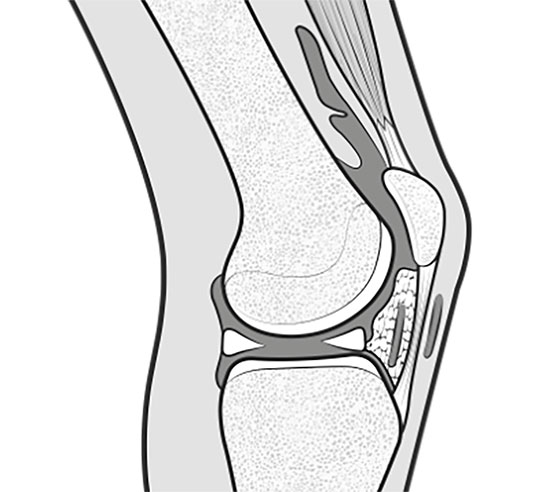
KAF
Knee Arthrofibrosis
Arthrofibrosis is characterized by an abnormal scarring within the knee joint as well as in the peri- and extra-articular structures. It is a complication of injury or surgery (even coming from minor procedures, such as a partial meniscectomy) where an exaggerated inflammatory response leads to excessive and abnormal scar tissue formation therefore to painful restriction of the knee range of motion (ROM).
Arthrofibrosis can evolve to include muscle atrophy, patellar tendon shortening, and a localized or generalized scarring inside and outside the knee joint. Scarring can involve the whole joint capsule which becomes thickened. The shortened patellar tendon and the scarred fat pad often stick together, pulling the tendon towards the centre of the knee and resulting in patella baja (infera). The combination of the above-named factors tightens up the whole joint which becomes stiff, and in the most severe cases of knee arthrofibrosis there is minimal to no patellar mobility.
Lack of full extension and patella baja can ultimately lead to cartilage damage due to the increased compression forces on the patello-femoral joint.
With this pathology a highly specialized rehabilitation program is pivotal. Specialized physical therapy for knee arthrofibrosis requires a great deal of expertise and focuses on gentle restoration of ROM, inflammation, and swelling management, with adequate pharmaceutical support and pain normalization. Abnormal pain and hypersensitivity of the knee often results from either peripheral or central nervous system sensitization. Peripheral sensitisation occurs from the effects of inflammation on nerves and the ingrowth of sensory neurons into the joint.
A team of specially trained Physical Therapists is essential for recognizing the symptoms of early onset knee arthrofibrosis and immediately adapting the rehabilitation plan. Furthermore, in cases where this approach proves not to be enough, the Physical Therapist needs to rapidly contact the orthopaedic surgeon (who needs to be skilled in dealing with such pathology) to add pharmaceutical support and sometimes plan a tailored surgical intervention.
Quad strengthening is not the focus when treating knee arthrofibrosis. Pushing the knee through aggressive rehabilitation to recover the lacking flexion and/or extension only aggravates the situation.
Efforts should focus on adequate pain relief while recovering ROM and making adhesions and scar tissue more pliable and elastic, ultimately leading to their remodelling via plastic deformation and (if possible) partial/complete reabsorption without further inflaming the knee. Treating ROM deficits requires a high level of patient compliance and adherence to a specialized program that has to be followed both in physical therapy and at home, with the use of some specific devices if necessary.
The Sports Rehab team is specialized in the management of this potentially devastating knee pathology and strives to offer patients the best overall care. We take into consideration all the necessary aspects and base treatments on the science of fibrosis pathology.
Part of our team spent a considerable time studying this often-undiagnosed knee pathology in some of the world's best Sports Medicine and Orthopaedic Clinics in the United States, developing an in-depth understanding of the mechanisms, causes, complications and approaches. These clinics included the Steadman Clinic (Vail, CO), the Cincinnati SportsMedicine & Orthopaedic Center/Dr. Noyes Knee Clinic (Cincinnati, OH), the Andrews institute (Gulf Breeze, FL), and others.
A multi-disciplinary treatment approach is crucial in this complex pathology, and for this reason our team work closely with knee orthopeadic surgeons and specialists all over the world to manage each knee arthrofibrosis case at its best.
Surgery needs to be performed by a knee surgeon who has developed an understanding of the pathology of arthrofibrosis and expertise in dealing with it, since the surgical techniques and the immediate post-operative care are specific to arthrofibrosis, and normal surgical methods shouldn't be used.
When surgery is performed to restore ROM of the knee and release scar tissues, etc. we start our specialized physical therapy regimen immediately after the surgical procedure, in bed, with Continue Passive Motion machine, ice and compression, and potentially extension splints. Rehabilitation must be performed every day, with a strict program. The priority is to regain and maintain ROM while quieting the knee down to re-establish its homeostasis (normality) in the first 6-8 weeks, depending on the individual. Our skilled Physical Therapists will guide you through this process.
We cooperate with the International Arthrofibrosis Association (IAA) and KNEEguru.co.uk website in helping patients dealing with knee AF from all over Europe (see our co-founder profiles as member of the IAA Committee and member of the KNEEguru Clinical Advisory Board).
Informative material on knee AF:
- knee AF explanatory video by Dr. Sheila Strover (KNEEguru):
www.kneeguru.co.uk/KNEEnotes/videos/what-arthrofibrosis -
Video-introduction to the management of knee arthrofibrosis by Sebastiano Nutarelli (1 hour - in Italian):
www.youtube.com/watch?v=Tfs_wZ5Y8AE - guide on knee AF by Dr. Frank Noyes (part of our staff was trained in his knee clinic in Cincinnati, OH - USA both in rehabilitation and the operative room):
www.kneeguru.co.uk/KNEEnotes/courses/arthrofibrosis-12-part-course?action - Arthrofibrosis Awareness Day 2023 - Expert Interview with Sebastiano Nutarelli by Dr. Kayley Usher, PhD of the Intl. Arthrofibrosis Association (42 mins - English language):
www.youtube.com/watch?v=rUkZ9YriTs0 - PDF guide on how to perform patellar mobilizations by the Sports Rehab co-founder, Sebastiano Nutarelli:
www.kneeguru.co.uk/KNEEnotes/ebooks/how-perform-patellar-mobilisations - PDF guide on cornerstones of early knee rehabilitation by the Sports Rehab co-founder, Sebastiano Nutarelli:
www.kneeguru.co.uk/KNEEnotes/ebooks/cornerstones-early-knee-rehabilitation - International Arthrofibrosis Association (IAA) Twitter and Facebook accounts